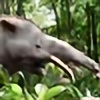HOME | DD
 DiBgd — Pyrotherium romeroi
by-nc-nd
DiBgd — Pyrotherium romeroi
by-nc-nd

Published: 2014-04-02 18:00:08 +0000 UTC; Views: 7078; Favourites: 123; Downloads: 0
Redirect to original
Description
Pyrotherium romeroiRelated content
Comments: 32

You know what's funny? When I first saw the pyrotherium, I thought it looked like a relative of moeritherium. But when I looked it up, it wasn't. It was actually a Xenungulate (or at least an animal that belonged to a unique family of ungulate-type animals, but not odd-toed ungulates like the similar tapir, or even-toed ungulates like pigs).
👍: 0 ⏩: 1

We don’t know if pyrotheres were xenungulates.
👍: 0 ⏩: 2

👍: 0 ⏩: 0

Oh well. The evidence of every prehistoric animal and their environment (including plants, fungi, bacteria, etc) are known to hold a lot of mysteries and secrets we can't figure out (whether we solve any of them or not).
👍: 0 ⏩: 0

I don't know what it is but it's adorable and I want one!!!
👍: 0 ⏩: 0

Nice, I appreciate that it looks not specially elephant-like
👍: 0 ⏩: 0

Ah, one of nature's ugliest creations... well done!
👍: 0 ⏩: 0

Ah yes, an ancient and distant cousin of the Macrauchenia and Toxodon.
👍: 0 ⏩: 1

I remember reading about the controversies of that group, particularly among xenungulates in which they might be evolutionary distant cousin to us.
👍: 0 ⏩: 2

You mean like how the uintatheres/dinoceratans may have evolved from a group of rabbit-like animals, and that the uintatheres may have came down from North America into South America (possibly via island hopping) into South America during the Paleocene?
👍: 0 ⏩: 1

That might be true, though, we still need to determine if uintatheres are related to that group, and if that group really is a member of Euarchontoglires, and if uintatheres were able to swim into South America.
👍: 0 ⏩: 1

I agree! Has there been any recent phylogenetic study that involved those mammals?
👍: 0 ⏩: 1

Well, when you put Pyrotheres, Astrapotheres, Xenungulates, Notoungulates and Litopterns together, that makes up Meridiungulates, coming from the same ancestors and Xenarthrans did.
👍: 0 ⏩: 2

Pyrotheres and Astrapotheres might actually be closer to proboscideans, whilst the rest of these weird groups of South-American mammals (Litopterns, Notoungulates, Xenungulates, did I miss one?) would likely be related to ungulates, but split off from that branch very early.
👍: 0 ⏩: 1

We definitely have more questions than answers.
I sense that the Meridiungulates, the Xenarthrans and the Afrotheres fit together in a clade of placental Eutherians called Atlantogenata.
👍: 0 ⏩: 1

I think the group might have been polyphyletic, with some being close to, or even members of, the Afrotheria, whilst other might have been Laurasiatheres, however, I think Xenarthrans are more basal then Afrotheres and Laurasiatheres, and therefore not particularly closely related to Meridiungulates (if you can even call that one group of animals at all). But that is my take on it, I am not a qualified paleontologist or anything.
👍: 0 ⏩: 1

Like I said, we always have more questions than answers
👍: 0 ⏩: 1

That is one theory. The alternatives include that they are are related to perissodactyls another that this is a polyphyletic grouping with some related to primates and rabbits, others to elephants and others to artiodactyls.
👍: 0 ⏩: 2

What theory is this? I haven't read it. I'm interested.
👍: 0 ⏩: 1

Then you could be interested in these papers:
Billet, Guillaume. "New observations on the skull of Pyrotherium (Pyrotheria, Mammalia) and new phylogenetic hypotheses on South American ungulates." Journal of mammalian evolution 17.1 (2010): 21-59.
Agnolin, Federico L., and Nicolás R. Chimento. "Afrotherian affinities for endemic South American “ungulates”." Mammalian Biology-Zeitschrift für Säugetierkunde 76.2 (2011): 101-108.
Billet, Guillaume, and Thomas Martin. "No evidence for an afrotherian-like delayed dental eruption in South American notoungulates." Naturwissenschaften 98.6 (2011): 509-517.
Cifelli RL (1993) The phylogeny of the Native South American Ungulates. In: Szalay FS, Novacek M, McKenna MC, editors.Mammal Phylogeny. II Placentals. Springer-Verlag, 195–216.
👍: 0 ⏩: 0

Yet even though they may resemble certain other Mammals, that does not mean they are necessarily closely related to them.
👍: 0 ⏩: 1
























